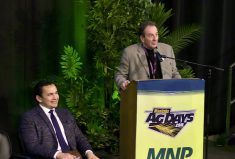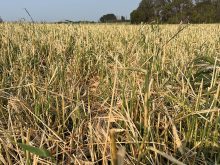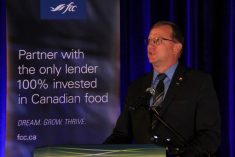The deadline for making crop insurance changes for the coming season, or enrolling for the first time, is nearly here.
The March 31 deadline is a Sunday this year so Manitoba farmers have until Monday, April 1, says David Van Deynze, vice-president of insurance operations at the Manitoba Agricultural Services Corporation (MASC), which administers the province’s crop insurance program, also known as AgriInsurance.

“Our premium rates (farmers pay for coverage) are down (on average) about seven per cent,” Van Deynze said. “That’s largely because we’re putting more money in the bank (surplus) each year and we return it back to farmers when it makes sense (through lower premiums).
“We’re not in it to make money. We’re in it to be sustainable over the long term.”
After several years of good crops and lower insurance payouts, the crop insurance surplus has grown to the point where premiums can be reduced, Van Deynze said.
Some surplus is needed to prevent premiums going through the roof following a major crop failure, he added.
Most premiums and coverage are based in part on each farmer’s production history and those in their risk area.
Read Also

Manitoba sclerotinia picture mixed for 2025
Variations in weather and crop development in this year’s Manitoba canola fields make blanket sclerotinia outlooks hard to pin down
For some crops such as corn, each farmer’s individual long-term average yield is used.
Most values higher
The value of most insured crops is up a little bit from last year.
For those in a claim position in 2019 the values for canola, soybean, hard red wheat and northern hard red wheat are $10.89, $10.48, $6.67 and $5.85 a bushel, respectively.
The soybean value is down 13 cents a bushel from 2018, while northern hard red is up 54 cents. See the full list of 2019 crop values at the MASC website.
The deadline for changes to Excess Moisture Insurance (EMI) coverage for 2019 was Nov. 30, 2018. Farmers who made no changes will receive the same EMI coverage as last year.
New farmers will automatically get $50 an acre in EMI coverage.
Farmers can buy $75- and $100-an-acre EMI coverage and also buy down the deductible, but only before the deadline.
The minimum deductible is five per cent of covered acres. So a farmer with EMI coverage on 1,000 acres would have to have at least 51 acres too wet to seed to qualify for a payout on just one acre after the deductible.
If all 1,000 acres were too wet to seed the farmer would receive an EMI payout on 950 acres.
Novel crops
Last year MASC introduced insurance for novel crops and it continues to be available, Van Deynze said. The program was set up for small-acreage crops lacking yield history or price discovery.
There are three coverage options — $120, $160 or $200 an acre.
“Ultimately (novel crop) losses are based on your other crops that we do insure,” Van Deynze said. “If you grow some quinoa and your wheat and canola and oats and barley don’t do that well we’ll make the assumption that your quinoa didn’t do so well by the same proportion ratio and we’ll make a payment on that basis.”
There are several changes to crop insurance this year, including separate insurance for hybrid fall rye. It yields more than open-pollinated rye so coverage is higher, Van Deynze said.
Coverage is higher for seed potatoes too, reflecting their higher cost of production and market value.
- The list of crops eligible for organic insurance has been expanded to include barley, field peas and hemp grain.
- Dollar values for organic crops will increase due to an update in how the dollar values are determined.
- The way forage claims are adjusted will change to better reflect losses due to low quality.
2018 payouts
The final tally on 2018 crop insurance payouts hasn’t been made yet, but it’s currently expected to be around $100 million, Van Deynze said.
“It was a good year for us honestly,” he said. “There certainly were some claims and some areas had some struggles, but overall it was a very good year.”
MASC has paid more than 4,200 claims made on the 2018 crop. But 2017 was even better with just 2,870 claims.
“2017 was one of the best years ever,” Van Deynze said.
EMI claims were low too in 2018. Around 35,000 acres were too wet to seed last year.
“2008 was the last time we had a number in that area,” he said. “It’s pretty normal to have 100,000 acres. Even in a good year we’ll have 100,000 acres too wet to seed.”
That’s around one per cent of Manitoba’s annual crop acres.
More than 8,000 Manitoba farms are enrolled in AgriInsurance. Manitoba has the highest level of AgriInsurance participation in Canada with more than 90 per cent of annual crop acres enrolled.
AgriInsurance is a federal-provincial program. The two governments are expected to contribute $125.07 million in premiums this year.
Under AgriInsurance, premiums for most programs are shared 40 per cent by participating producers, 36 per cent by the Government of Canada and 24 per cent by the Manitoba government.
Administrative expenses are paid 60 per cent by Canada and 40 per cent by Manitoba.




















